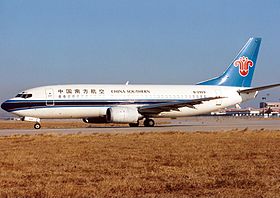China Southern Airlines Flight 3456
| China Southern Airlines Flight 3456 | |
|---|---|
|
An identical Boeing 737-300 from China Southern Airlines |
|
| Accident summary | |
| Accident type | Agreement from the runway |
| place |
Shenzhen Huangtian Airport , People's Republic of China |
| date | May 8, 1997 |
| Fatalities | 35 |
| Survivors | 39 |
| Injured | 9 |
| Aircraft | |
| Aircraft type |
|
| operator |
|
| Mark |
|
| Departure airport |
Chongqing-Jiangbei Airport , People's Republic of China |
| Destination airport |
Shenzhen Huangtian Airport , People's Republic of China |
| Passengers | 65 |
| crew | 9 |
| Lists of aviation accidents | |
On May 8, 1997, a Boeing 737-31B of China Southern Airlines ( aircraft registration number B-2925 ), which was being used for a flight from Chongqing to Shenzhen , crashed on China Southern Airlines flight 3456 . In the accident, 35 people were killed on board the machine, there were also nine injured.
plane
The aircraft concerned was a Boeing 737-31B, which was finally assembled at the Boeing plant in Renton , Washington , and which made its maiden flight on January 28, 1994. The aircraft had the factory number 27288, it was the 2577th Boeing 737 from ongoing production. The machine was delivered brand new to China Southern Airlines on February 25, 1994 . The twin-engine narrow-body aircraft was equipped with two Turbojettriebwerken type CFMI CFM56-3C1 equipped.
Passengers and crew
There were 65 people on board the machine, who were assigned a crew of nine. The flight captain was the 45-year-old Lin Yougui (Chinese: 林友贵), who had completed more than 12,700 hours of flight, including 9,100 hours as a radio operator and 3,600 hours as a pilot. The first officer was the 36-year-old Kong Dexin (孔德 新), who had completed more than 15,500 hours of flight, of which 11,200 hours as a flight engineer and 4,300 hours as a pilot.
Weather
The weather reported from Shenzhen Airport between May 8th at 5:00 pm and May 9th at 2:00 am was: "170 degrees wind with 7 meters per second (14 kn; 25 km / h) with rain, visibility from 20,000 feet (approx. 6,000 meters), cloud cover at a height of 4,900 feet (approx. 1,500 meters), winds changing at 15 meters per second (29 kn; 54 km / h), thunderstorms can occur. "
On May 8th at 6:00 p.m. a storm warning was issued: "Report to airports, air traffic control and airlines: Thunderstorms with strong winds will occur, all departments including the crew taking off should be notified." The following weather was reported at 9:33 p.m.: wind from 290 degrees at 7 meters per second (14 kn; 25 km / h), visibility of 6,600 feet (approx. 2,000 meters), showers, low clouds at a height of 690 feet (approx. 210 meters), cumulonimbus at an altitude of 3,900 feet (approx. 1,200 meters) at temperatures of 23 ° C.
the accident
On May 8, 1997, the plane took off from Chongqing-Jiangbei International Airport at 7:45 pm local time ( UTC +8) and was expected to arrive at Shenzhen-Huangtian Airport at 9:30 pm. At 9:07 p.m., air traffic control at Shenzhen Airport assigned the aircraft to runway 33. At 21:17, the tower informed the crew of heavy rain on the final approach. At 21:18:07 h the crew announced that they had decided on an ILS approach. At 21:18:53 p.m., the crew informed air traffic control that they had seen the approach lights, and the air traffic controller issued the landing permit. At 21:19:33, the machine landed hard in the southern part of the runway and rebounded three times, damaging the nose landing gear, hydraulic systems and buoyancy aids of the machine. The crew decided to take off . The machine rose again to an altitude of 1,200 meters and turned to the left. The crew were asked to turn on the transponder to show air traffic control their position, but the secondary surveillance radar received no signal from the aircraft, indicating that the transponder was turned off or defective. At 21:23:40 the crew declared an air emergency. At this point in time, the main warning message, the warning message for the hydraulic system and the warning message for the landing gear in the cockpit were all activated simultaneously. The pilots reported that they wanted to land on the runway heading south, which was approved. At 9:28:30 p.m., the machine rolled over the end of the runway, broke into three parts and caught fire, killing 33 passengers and 2 crew members.
Accident investigation
Scattered debris of the nose landing gear was found at the southern end of the runway, suggesting that the left front tire exploded when it touched down, especially as the first attempt to land was made in a northerly direction. On the runway surface there were also rivets, sheet metal, rubber hoses and retaining clips in this area.
The second attempt to land was carried out in a southerly direction. A clear surface scratch on the hull was discovered 427 meters from the runway threshold. The plane broke apart after rolling over the end of the runway by about 600 meters and went up in flames. The middle part of the fuselage and the trailing edge of the right wing had been hardest hit by the fire. Large amounts of mud had entered the deformed cockpit. The rear part of the fuselage was relatively intact and the only section not completely destroyed. The left main landing gear and right engine were scattered on the left side of the runway.
swell
- Accident report 737-300, B-2925 in the Aviation Safety Network
- Company history 737-300, B-2925 on planespotters.net
- Description of the accident on baike.baidu
Coordinates: 22 ° 38 ′ 24.7 " N , 113 ° 48 ′ 39.2" E
